What is bonsai Jin & Shari
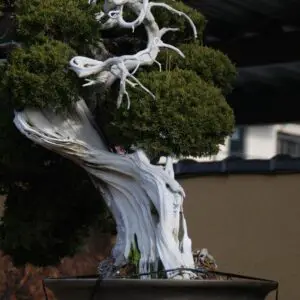
Shari and Jin
Jin and Shari are two important techniques in bonsai that involve the use of deadwood to enhance the aesthetic appeal of your trees. Jin refers to the deadwood on the branches of your tree, while Shari is the deadwood on the trunk.
This deadwood on a living tree can happen naturally due to strong winds and thunder. Jin and Shari are a simple reflection of this phenomenon in a bonsai scenery.
Bonsai deadwood is used to create a variety of effects in bonsai, including making a sense of age, symbolizing life and death, making the tree more visually interesting and hiding defaults, if any.
For more information about bonsai deadwood, the following post might be helpful.
How to choose species for bonsai deadwood
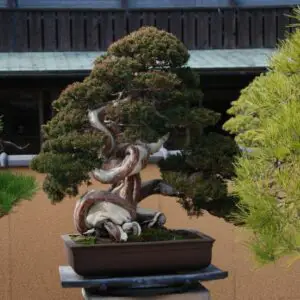
The ideal bonsai tree for the deadwood technique is one that saps lots of natural resins and has rough and textured bark, i.e. coniferous trees. Pine, juniper, spruce, cedar, fir, yew, and larch are included in the resinous species that are suitable for bonsai deadwood.
Jin and Shari are particularly effective on and are well-known for Shimpaku junipers, a popular bonsai species known for its beautiful blue-green foliage. One of the reasons why Shimpaku juniper is good for bonsai deadwood is that its dead branches are naturally whitish (cream white) without chemicals.
How to choose the right area for Jin and Shari
Tips for choosing the right area for deadwood
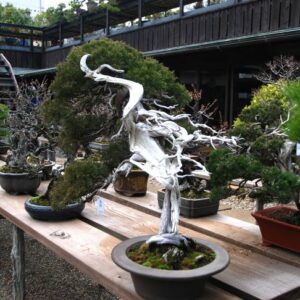
Japanese Shimpaku juniper (masterpiece)
Before you start creating Jin and Shari, it is important to choose the right branches and trunk sections to work with. Too many Shari and Jin look unnatural and even unpleasant to the viewers. So, it is crucial to carefully consider which branches should be left and where deadwood should be positioned before creating it.
Here are some tips to help you select the best areas for Jin and Shari creation.
Visual interest
First, choose areas of the tree that will benefit from the addition of deadwood to create a more intriguing shape. Jin and Shari should be used to create visual interest in your bonsai.
For that, it is ideal to use Jin and Shari to highlight the part that is most appealing when viewed from the “front” of the tree.
When displaying a bonsai, it should be positioned from the side that looks most aesthetically pleasing from the viewing angle. This is called the “front” of the tree and Jin and Shari should be admired from the front, not hiding in the back.
Overall balance
Consider the overall balance of your tree. Too many Shari and Jin look unnatural and even unpleasant to the viewers. Take a look at the branches and the trunk from different angles and identify those that can be used as Jin and Shari based on their size and position.
You can surely make a very interesting shape with the bonsai deadwood technique but it needs practice and experience. If you are a beginner, look for branches or trunk sections that have interesting curves or twists that will be enhanced by the addition of deadwood.
Complementing the natural form of your tree with Jin and Shari is much easier than creating an avant-garde shape.
Creative shape
Instead of simply removing the bark, you can create interesting shapes by bending and twisting Jin (branches) with wire.
If you wish to alter the shape of the Jin branch, you can wire it after removing the bark, or you can use wire to bend the branch you plan to turn into Jin and make Jin once it has a desired shape.
Jin and Shari for Shimpaku juniper: the attempt

Nursery stock Shimpaku juniper
Spring is the best time for creating bonsai deadwood and I decided the other day to experiment with creating Jin and Shari on a nursery stock Shimpaku juniper bonsai. The first step in this process is to select the right areas for the deadwood.
First, I considered the visual interest of each area – some parts of the tree had more interesting patterns of branches and curves that would make for more striking deadwood features. I also selected the front of the tree which looked most pleasing and interesting with the deadwood feature.
I looked at the overall shape and balance of the tree as well. As this tree already had interesting curves and twists, I thought going bold on creating deadwood can be more on the artistic side than unnatural.
Bonsai is an art form, and I wanted to use the Jin and Shari to create a unique and visually engaging composition this time.

Where to make Jin and Shari
So, instead of creating one or two branches into Jin, I decided to make a major part of the tree into Jin branches and its continuous part of the trunk into Shari.
How to make Jin and Shari bonsai
Tools for creating Jin and Shari
Before you begin the process of creating Jin and Shari on your bonsai tree, it is important to make sure you have the right tools at hand. Here are some of the tools you need to create Jin and Shari on the live branches and trunk.
- Bonsai scissors: Bonsai scissors will be needed to prune the leaves on the branches you are making into Jin.
- Pliers: Pliers will help to peel off the tree bark.
- Carving tools: Carving tools such as a carving knife or chisels are essential for creating and refining deadwood. Choose tools that are sharp and easy to handle.
- Sandpaper: Sandpaper will be needed to smooth out the edges of the deadwood and create a more natural-looking finish. Choose sandpaper with a range of grits, from coarse to fine.
- Preservative: A preservative such as lime sulfur will help protect the deadwood from decay and insects.
A step-by-step guide for creating Jin
Jin, or bonsai deadwood, is a beautiful and unique feature that can add character and depth to your bonsai. Here’s a step-by-step guide to creating Jin on a branch of your bonsai tree.
Step 1: Choose the right branch
Select a branch that is in a prominent position on the tree and will add visual interest to your overall design. I’ve laid out for you the whole process of choosing the right area for creating Jin in the previous section of this post.
You can also look for a branch that is already dead or dying, as this will make it easier to create Jin.
Step 2: Prune the foliage
Cut off leaves from the branches where you want to create deadwood to make the work easier.
Step 3: Remove the bark
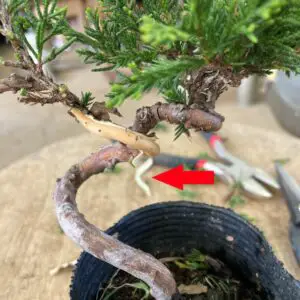
Peeling bark (creating deadwood)
Using pliers, softly press the branches you want to remove the bark from. Begin with the tips of the branches till the end where they are attached to the trunk. Press again from different angles. After a couple of times, the tree bark (and softwood) will come off naturally and you can peel it with your fingers.
If the bark is still attached to the branches, use a sharp knife, chisel or plier to carefully remove the bark from the selected branch. This will expose the inner wood (sapwood) and create the foundation for your Jin.
Step 4: Remove the sapwood
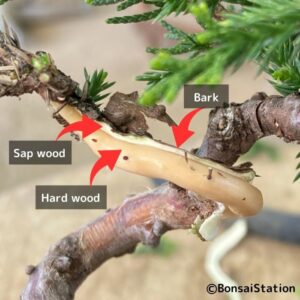
Peeling sapwood (creating deadwood)
Use a carving knife or chisels to carefully take off the sapwood from the hardwood. Sapwood is whitish in color and is the pipe of trees through which water and nutrients are transported throughout their body. So, taking sapwood off kills that part of the tree.
If the tree is young and small, you may use your fingernail to remove sapwood.
Be careful not to remove sapwood from the parts which you want to live as it may peel off along with the part you are trying to remove.
Step 5: Carve the edge of the deadwood
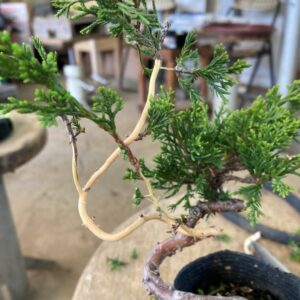
Creating deadwood
Use a carving knife or chisels to carefully carve the edge of deadwood to refine the boundary of the deadwood branches and the living trunk. Be careful not to remove sapwood from the trunk as it can weaken the tree.
Step 6: Sand the deadwood
Once you have created Jin, use sandpaper to make the exposed hardwood somewhat rough and damaged. This is an optional step to create a more natural-looking finish because freshly peeled hardwood is very smooth and looks like it has been made very recently (which is true though).
Plying the tips of Jin branches or intentionally breaking them can give them a more naturalistic look.
Step 7: Apply a preservative
A few months after creating deadwood, apply a preservative such as lime sulfur to the deadwood to protect it from decay and insects.
If you use it immediately after making deadwood, it may damage the wound at the boundaries of the trunk and interferes with the tree’s ability to absorb water. It is safer to apply it when the wound has healed, which is a few months later.
A step-by-step guide for creating Shari
Shari is a technique used in bonsai to create a deadwood feature on the trunk of the tree. Unlike Jin, which is created on branches, Shari involves removing bark from the trunk to expose the natural wood underneath.
Here’s a step-by-step guide for creating Shari on your bonsai tree.
Step 1: Choose the right spot
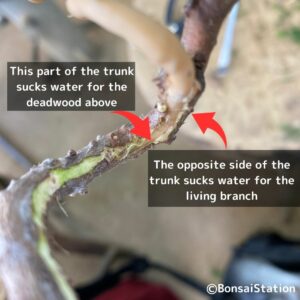
Choose the right spot for Shari
Select an area on the trunk where you want to create the Shari. The aesthetic is important but you also have to think about the branches that you want them to thrive. Removing sapwood from the wrong part of the trunk may kill the branches that depend on it.
Sapwoods are like pipes that transport water and nutrients from the roots of a plant to the rest of the plant. These cells are long, tube-like structures that are stacked end-to-end forming a long pipeline that extends throughout the plant.
Make sure not to cut off the sapwood in the middle.
Step 2: Remove the Bark

Leave the bottom of the bark intact when making Shari.
Using a sharp knife, carving tool or a plier, carefully remove the bark from the chosen area. Begin from the bottom of the trunk and work your way up. If the width of Shari is narrow, making two small incisions alongside the edge of Shari you want to make with a knife will make it easier to peel off the bark.
Be careful not to remove too much of the bark of the tree as it can be stressful.
Peel off the bark slowly along the water vessel of the trunk. If your tree has curves or twists, the water vessel has the same curves or twists.
Make sure to leave the very bottom of the bark intact. This part of the tree has frequent contact with water and soil, which may cause rot if you peel off the bark.
Step 3: Remove the sapwood
Use a carving knife or chisels to carefully take off the sapwood from the hardwood. Be careful not to remove sapwood from the parts which you want to live as it may peel off along with the part you are trying to remove.
When creating Shari in a large portion of the trunk, it is better to gradually complete it over several years because it is a very stressful process for a bonsai tree.
Step 4: Carve the edge of the deadwood
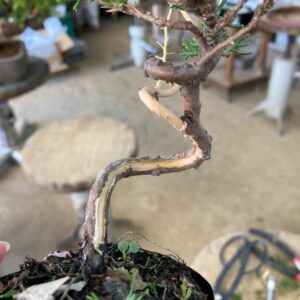
Shari bonsai
Use a carving knife or chisels to carefully carve the edge of deadwood to refine the boundary of Shari and the living portion. Be careful not to remove sapwood from where you want it to be intact.
Step 5: Sand the deadwood
After removing the softwood, use a sanding tool to smooth the surface of the exposed wood. Making it somewhat rough and damaged can make an interesting feature of the deadwood.
Step 6: Apply a preservative
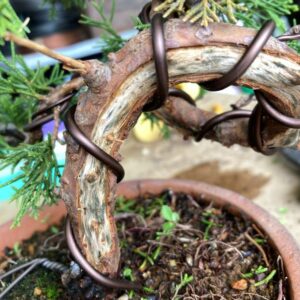
Shari became moldy (different Shimpaku tree).
A few months after creating deadwood, apply a preservative such as lime sulfur to the deadwood to protect it from decay and insects (link to the online store at Bonsai Boy).
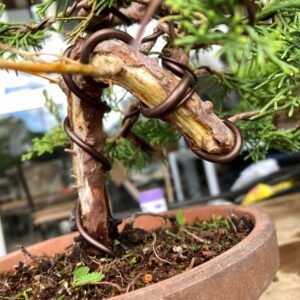
Putting lime sulfur (it becomes white after drying.)
If you use it immediately after making deadwood, it may damage the wound at the boundaries of the trunk and interferes with the tree’s ability to absorb water. It is safer to apply it when the wound has healed, which is a few months later.
Bonsai deadwood after care
Jin and Shari are beautiful techniques that can enhance the natural beauty of your bonsai tree and properly taking care ensures the longevity and health of your tree.
Here are some tips for caring for your bonsai with Jin and Shari after you created them.
Protecting Deadwood
Jin and Shari are susceptible to decay and insect damage. To protect your deadwood, regularly check for signs of decay or insect infestation and treat as needed. You can also apply a preservative like lime sulfur at least once a year to the deadwood to help prevent damage (link to the online store at Bonsai Boy).
Fertilizing
Refrain from fertilizing your bonsai about a month after making Jin and Shari. It is a stressful procedure and giving nutrients may be another stressor.



